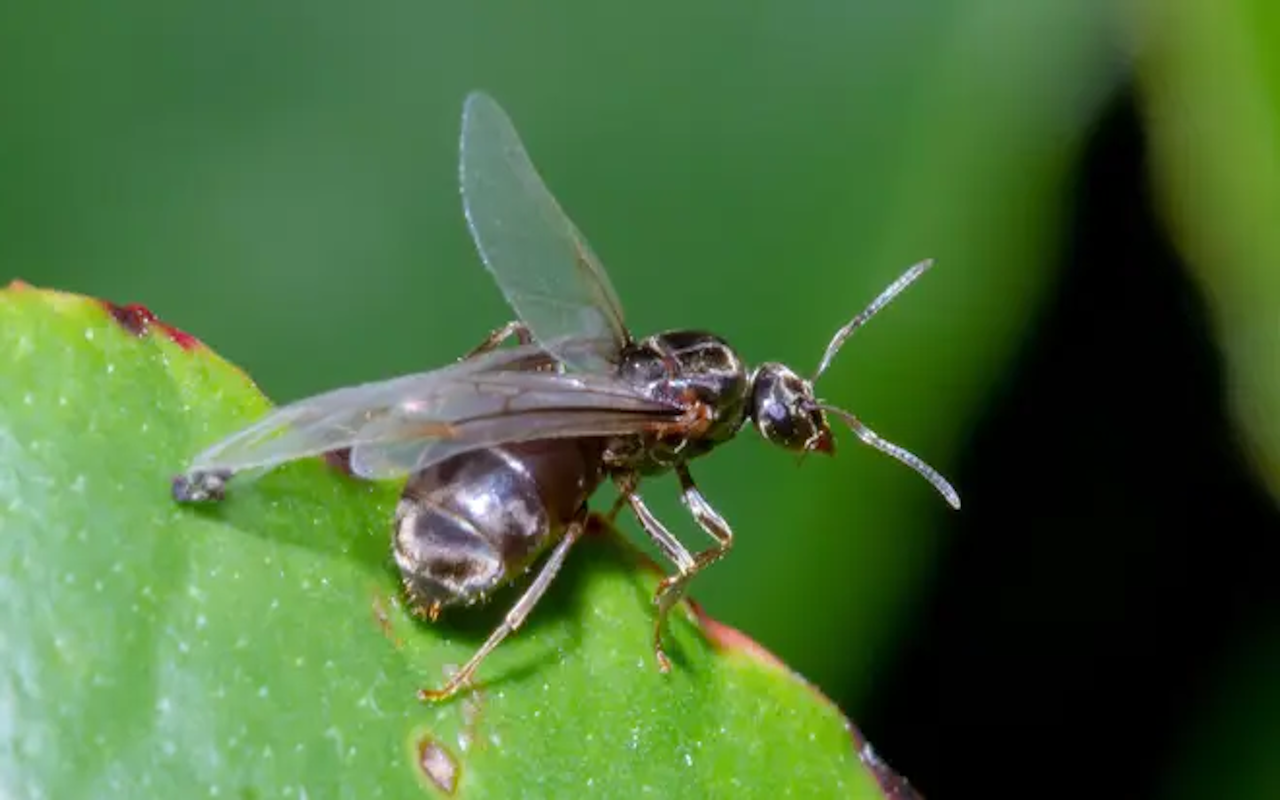As summer progresses across the United Kingdom, a familiar and often overwhelming natural phenomenon is gearing up for its annual appearance.
However, this year, experts are warning that the upcoming Flying Ant Day could be significantly larger than in recent memory. This unique event, characterized by millions of winged insects taking to the skies, is an annual spectacle that marks a crucial phase in the ant reproductive cycle. While it occurs every year, conditions in 2025 appear to be aligning to create an unprecedented influx.
Specialists from Bestantsuk, a leading authority on ant behavior and control, have issued a prediction that “Flying Ant Day in 2025 is predicted to occur earlier than usual, with peak activity anticipated around July 22 and 25.” This specific timeframe provides a clearer expectation for when the public should brace themselves for the widespread swarms.
These experts have also highlighted that initial waves of flying ants have already begun to appear in Britain’s major cities from June onwards. This earlier emergence is attributed to the warming effect of large buildings and dense human populations, creating microclimates that accelerate ant colony activities. The sheer scale and timing of this year’s expected emergence are prompting entomologists and pest control experts to advise the public on what to expect from what could be one of the most prolific “Flying Ant Days” the UK has seen in years.
Understanding Flying Ant Day: More Than Just a Day
Despite its singular name, “Flying Ant Day” is a complex biological event that spans several days, peaking under specific environmental conditions.
The Nuptial Flight Explained
Despite its commonly used moniker, “Flying Ant Day” is, in reality, a misnomer. This significant natural event actually takes place over several days, typically spanning around 45 days during the summer months. The term “day” often refers to the peak period when the most visible and widespread swarms occur. It is a crucial biological event known as the nuptial flight, sometimes colloquially nicknamed “flant day” by the public. During this period, vast numbers of winged ants, scientifically referred to as alates, emerge from their colonies.
These alates consist of two types: flying queens, which are typically larger in size, and smaller male flying ants. Their collective purpose during this synchronized emergence is to take to the skies in search of mates from other colonies. This mass aerial display is essential for genetic diversity, preventing inbreeding within a single colony. After mating in the air, the newly fertilized queens will shed their wings and seek out suitable locations to set up new colonies, while the males typically die shortly after.
This ensures the continuation and expansion of ant populations. The sheer volume of insects involved during these peak days can be quite striking, creating a temporary, but noticeable, presence in the environment as millions participate in this vital reproductive ritual.
Ideal Conditions for Massive Swarms
The timing and scale of the “nuptial flight” are heavily dependent on very specific environmental conditions. While the event spans several days, it peaks on two or three days when conditions are absolutely ideal for massive swarms. Scientists have observed that ants, in their collective behavior, can almost act as a short-term weather forecaster, as they instinctively choose the most opportune time to emerge. The perfect conditions for these mass aerial journeys involve a combination of warmth and calm. They require a warm and calm day to travel, as strong winds or cold temperatures would hinder their ability to fly effectively and find mates.
According to Rentokil, a leading pest control expert, the current weather patterns in the UK are creating precisely these optimal conditions. They specifically point to the high humidity levels this summer as ideal for providing the perfect breeding ground for ant swarms. Humidity plays a crucial role in the ants’ ability to undertake their flight.
As Paul Blackhurst, Technical Academy Head at Rentokil Pest Control, explains: “The alternating wet and warm weather we have been experiencing recently is creating the perfect conditions for larger-than-usual swarms, as humidity is important in keeping the ants’ wings and bodies moist during flight and ‘mating on the wing’.” This delicate balance of warmth, calm, and high humidity ensures that the ants’ bodies remain hydrated and their wings flexible, allowing for successful dispersal and reproduction. These specific meteorological factors are precisely why experts anticipate a particularly prolific “Flying Ant Day” this year.
Why This Year is Different: Factors Influencing a Larger Swarm
Several environmental factors are converging to suggest that the UK will experience an unusually large number of flying ants this year.
The Urban Heat Island Effect
One significant factor contributing to the earlier and potentially larger emergence of flying ants in the UK, especially in metropolitan areas, is the urban heat island effect. Experts at Bestantsuk have explicitly warned that “Urban areas experience earlier flying ant emergencies due to the heat island effect.” This phenomenon refers to the fact that cities maintain higher temperatures than surrounding rural areas.
This temperature differential is caused by several factors inherent to urban environments: dark surfaces like asphalt and rooftops absorb and retain more heat, buildings block wind patterns, and human activities, such as vehicle emissions and industrial processes, generate heat.
This elevated urban temperature creates microclimates that trigger premature ant colony activities. As Bestantsuk elaborated, this is “particularly in places like London,” where the effect is most pronounced due to its vast concrete infrastructure and dense population. The warmer conditions accelerate the development cycle of ant colonies located within city limits. This means that ants in urban areas may reach their reproductive stage and be ready for their nuptial flight sooner than their rural counterparts. Consequently, residents in major cities might experience the swarms earlier and potentially in greater concentrations as the local conditions become ideal before the broader national emergence. This localized warming acts as a catalyst, contributing to the overall scale and timing of “Flying Ant Day” across the country.
Alternating Wet and Warm Weather Patterns
Beyond the urban heat island effect, the broader meteorological patterns across the UK are also playing a crucial role in predicting a larger-than-usual swarm. Experts, including Paul Blackhurst of Rentokil Pest Control, have highlighted the significance of the “alternating wet and warm weather” that the country has been experiencing recently. This specific combination of conditions is not coincidental; it is widely understood to be creating the perfect environment for larger-than-usual swarms of flying ants.
The warmth provides the necessary temperature for the alates to emerge and take flight, ensuring they are active and capable of sustained aerial movement. However, the wet periods are equally, if not more, critical. These periods of rain or high humidity ensure that the soil remains moist, which is essential for the ant colonies’ development underground. Critically, as Blackhurst emphasizes, “humidity is important in keeping the ants’ wings and bodies moist during flight and ‘mating on the wing’.”
Without sufficient moisture in the air, the delicate wings of the alates can dry out and become brittle, making sustained flight difficult or impossible. Furthermore, dry conditions can hinder the successful mating process that occurs in the air. Therefore, the consistent pattern of warmth followed by moisture creates an optimal physiological environment for the ants, allowing a greater number of them to successfully mature, emerge, and participate in the nuptial flight. This combined weather pattern is a key driver behind the expert predictions of a particularly prolific “Flying Ant Day” this year.
Impact and Implications: What to Expect and How to React
While often a nuisance, the large swarms of flying ants are a natural phenomenon with limited negative impact, though they can be a temporary inconvenience.
Temporary Nuisance, Not a Threat
For residents across the UK, the prospect of a “bigger Flying Ant Day” often brings thoughts of annoyance and inconvenience. During peak swarming periods, millions of winged insects swarm the skies, creating a noticeable presence in gardens, parks, and even urban streets. These swarms can appear suddenly and densely, leading to situations where people find themselves surrounded by flying ants.
While this can be unsettling or even startling, especially for those who are not expecting it, it is crucial to remember that these ants are generally harmless to humans. They are not typically aggressive, and their primary focus is on mating. Unlike some other insects, they do not bite or sting (unless provoked to an extreme degree, which is rare).
However, they can be a temporary nuisance. They may fly into open windows, get caught in hair, or land on clothing, which can be irritating. Outdoor activities can be briefly impacted as swarms pass through. Despite the overwhelming numbers, this period of intense activity is relatively short-lived for any given area, peaking for only a few days. The ants disperse after their mating flight, with the males dying and the queens seeking new nesting sites. Therefore, while the scale of this year’s predicted swarms might be larger, the fundamental nature of the event remains a fleeting natural spectacle rather than a long-term pest problem.
Practical Tips for Managing Swarms
While flying ants pose no serious threat, their sheer numbers can be bothersome. There are several practical tips individuals can follow to manage the temporary inconvenience. Firstly, keeping windows and doors closed during peak swarming hours can prevent large numbers of ants from entering indoor spaces. If ants do enter, a vacuum cleaner is an effective tool for quick removal. For outdoor areas, if a swarm is particularly dense and disruptive, a light spray of water can often encourage them to move on without harming them.
It’s also important to remember that this event is a natural part of the ecosystem. Ants play a role in soil aeration and can be a food source for birds. For those concerned about new colonies forming on their property, being aware of potential nesting sites (like under paving stones or in rotten wood) and sealing cracks in foundations can help prevent future infestations.
However, professional pest control is generally not necessary for the brief period of the nuptial flight, unless a significant indoor infestation persists beyond the swarming days, indicating an established colony. Understanding the nature of “Flying Ant Day” helps in reacting appropriately, mitigating the temporary nuisance while respecting the natural cycle.
Natural Spectacle on a Grand Scale
The UK is indeed bracing for what experts predict will be the largest “Flying Ant Day” in years, with peak activity expected around July 22-25. This natural phenomenon, driven by specific weather patterns of alternating wet and warm conditions and accelerated by urban heat island effects, sees millions of winged ants embark on their vital nuptial flight.
While the sheer numbers might be overwhelming, it’s crucial to remember that these swarms are a harmless, albeit temporary, summer nuisance. Understanding the science behind this event, from the role of humidity to the ants’ behavior as short-term weather forecasters, helps contextualize this annual spectacle. As the winged alates take to the skies in search of new colonies, the UK population can prepare for a truly grand display of nature’s intricate cycles.








